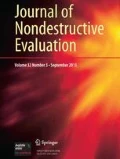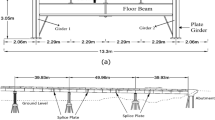Abstract
A damage identification scheme combining impact-synchronous modal analysis (ISMA) and artificial neural network is developed in this study. The ISMA de-noising method makes it feasible to detect and classify the damage states with high accuracy when the machine is under operation. The feed-forward backprop network was utilized in this study. The input feature vector of the network consisted of the FRF changes in a selected vibrational mode frequency interval at several measurement points. The scheme was tested on a rectangular Perspex plate. It is proved that the trained network can successfully identify damage locations with the testing data collected by ISMA, which allows the damage detection to be carried out without shutting down the tested machine. For the plate structure in this study, an overall accuracy reached 100% when all five measurement points were used. With the input features optimized by mode shape assessment, 100% accuracy was also achieved with only two measurement points.








Similar content being viewed by others
References
Fan, W., Qiao, P.Z.: Vibration-based damage identification methods: a review and comparative study. Struct. Health Monit. 10(1), 83–111 (2011)
Carden, E.P., Fanning, P.: Vibration based condition monitoring: a review. Struct. Health Monit. 3(4), 355–377 (2004)
Zhao, J., DeWolf, J.T.: Sensitivity study for vibrational parameters used in damage detection. J. Struct. Eng. 125(4), 410–416 (1999)
Jassim, Z.A., Ali, N.N., Mustapha, F., Jalil, N.A.A.: A review on the vibration analysis for a damage occurrence of a cantilever beam. Eng. Fail. Anal. 31, 442–461 (2013)
Guo, H.Y., Li, Z.L.: Two-stage multi-damage detection method based on energy balance equation. J. Nondestr. Eval. 30(3), 186–200 (2011)
Pandey, A.K., Biswas, M.: Damage detection in structures using changes in flexibility. J. Sound Vib. 169(1), 3–17 (1994)
Chen, H.L., Spyrakos, C.C., Venkatesh, G.: Evaluating structural deterioration by dynamic-response. J. Struct. Eng. 121(8), 1197–1204 (1995)
Salawu, O.S.: Detection of structural damage through changes in frequency: a review. Eng. Struct. 19(9), 718–723 (1997)
Li, J.C., Dackermann, U., Xu, Y.L., Samali, B.: Damage identification in civil engineering structures utilizing PCA-compressed residual frequency response functions and neural network ensembles. Struct. Control Health Monit. 18(2), 207–226 (2011)
Ren, W.X., De Roeck, G.: Structural damage identification using modal data. II: test verification. J. Struct. Eng. 128(1), 96–104 (2002)
Ren, W.X., De Roeck, G.: Structural damage identification using modal data. I: simulation verification. J. Struct. Eng. 128(1), 87–95 (2002)
Samman, M.M., Biswas, M.: Vibration testing for nondestructive evaluation of bridges. 1. Theory. J. Struct. Eng. 120(1), 269–289 (1994)
Samman, M.M., Biswas, M.: Vibration testing for nondestructive evaluation of bridges. 2. Results. J. Struct. Eng. 120(1), 290–306 (1994)
Schulz, M.J., Naser, A.S., Thyagarajan, S.K., Mickens, T., Pai, P.: Structural health monitoring using frequency response functions and sparse measurements. Soc. Exp. Mech. 1, 760–766 (1998)
Bayraktar, A., Turker, T., Sevim, B., Altunisik, A.C., Yildirim, F.: Modal parameter identification of hagia sophia bell-tower via ambient vibration test. J. Nondestr. Eval. 28(1), 37–47 (2009)
Dackermann, U., Smith, W.A., Randall, R.B.: Damage identification based on response-only measurements using cepstrum analysis and artificial neural networks. Struct. Health Monit. 13(4), 430–444 (2014)
Rahman, A.G.A., Ong, Z.C., Ismail, Z.: Effectiveness of Impact-Synchronous Time Averaging in determination of dynamic characteristics of a rotor dynamic system. Measurement 44(1), 34–45 (2011)
Rahman, A.G.A., Ismail, Z., Noroozi, S., Ong, Z.C.: Enhancement of Impact-synchronous modal analysis with number of averages. J. Vib. Control 20(11), 1645–1655 (2014)
Chao, O.Z., Cheet, L.H., Yee, K.S., Rahman, A.G.A., Ismail, Z.: "An experimental investigation on the effects of exponential window and impact force level on harmonic reduction in impact-synchronous modal analysis. J. Mech. Sci. Technol. 30(8), 3523–3532 (2016)
Ong, Z.C., Lim, H.C., Khoo, S.Y., Ismail, Z., Kong, K.K., Rahman, A.G.A.: Assessment of the phase synchronization effect in modal testing during operation. J Zhejiang Univ. A 18(2), 92–105 (2017)
Ong, Z.C., Lim, H.C., Brandt, A.: Automated impact device with non-synchronous impacts: a practical solution for modal testing during operation. J. Zhejiang Univ. A 19(6), 452–460 (2018)
Lim, H.C., Ong, Z.C., Brandt, A.: Implementation of phase controlled impact device for enhancement of frequency response function in operational modal testing. J. Franklin Inst. Eng. Appl. Math. 355(1), 291–313 (2018)
Hakim, S.J.S., Razak, H.A., Ravanfar, S.A.: Fault diagnosis on beam-like structures from modal parameters using artificial neural networks. Measurement 76, 45–61 (2015)
Hakim, S.J.S., Razak, H.A.: Adaptive Neuro Fuzzy Inference System (ANFIS) and Artificial Neural Networks (ANNs) for structural damage identification. Struct. Eng. Mech. 45(6), 779–802 (2013)
Yapar, O., Basu, P.K., Volgyesi, P., Ledeczi, A.: Structural health monitoring of bridges with piezoelectric AE sensors. Eng. Fail. Anal 56, 150–169 (2015)
Zang, C., Imregun, M.: "Structural damage detection using artificial neural networks and measured FRF data reduced via principal component protection. J. Sound Vib. 242(5), 813–827 (2001)
Tsou, P.Y., Shen, M.H.H.: Structural damage detection and identification using neural networks. AIAA J. 32(1), 176–183 (1994)
Su, H., Chong, K.T.: Induction machine condition monitoring using neural network modeling. IEEE Trans. Ind. Electron. 54(1), 241–249 (2007)
Ong, Z.C., Yap, E.T., Ismail, Z., Khoo, S.Y.J.M.W.C.: Assessment on structural integrity of in-service machine using de-noised vibrational modal data and artificial neural network. MATEC Web Conf. 237, 03002 (2018)
Acknowledgements
The authors wish to acknowledge the financial support and advice given by University of Malaya RU Geran (GPF001A-2018), Impact-Oriented Interdisciplinary Research Grant (IIRG007B-2019), Advanced Shock and Vibration Research (ASVR) Group of University of Malaya, and other project collaborators.
Funding
University of Malaya RU Geran (GPF001A-2018), Impact-Oriented Interdisciplinary Research Grant (IIRG007B-2019).
Author information
Authors and Affiliations
Corresponding author
Additional information
Publisher's Note
Springer Nature remains neutral with regard to jurisdictional claims in published maps and institutional affiliations.
Rights and permissions
About this article
Cite this article
Chen, S., Ong, Z.C., Lam, W.H. et al. Operational Damage Identification Scheme Utilizing De-Noised Frequency Response Functions and Artificial Neural Network. J Nondestruct Eval 39, 66 (2020). https://doi.org/10.1007/s10921-020-00709-x
Received:
Accepted:
Published:
DOI: https://doi.org/10.1007/s10921-020-00709-x




